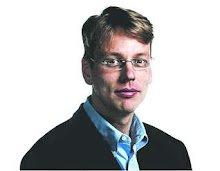Printed in the Iowa City Press-Citizen, Feb. 10, 2010.
When Ray Bradbury first published "Fahrenheit 451" back in 1953, the first-time sci-fi novelist was reacting largely against the McCarythism that permeated what he viewed as a fear-based, conformist culture. He likewise was reacting against other frightening facts of recent world history -- from Hitler's torching of books in Germany in 1934 to the rumor of Stalin employing "match people" throughout the U.S.S.R.
Pulling upon some of the persistent themes in his earlier short stories, Bradbury quickly turned a 25,000-word novella into a 50,000-word novel about a future society in which firemen start fires rather than stop them. He imagined a world in which television screens were so flat that they could be hung on walls, in which drivers could hum by at 75 miles an hour and in which the list of forbidden books could fill books of their own.
As explained in the novel, the social change didn't begin with any overt government coercion. It, instead, was cultural development in which people just started paying less attention to words and complex ideas and more attention to images and easily digestible pabulum. Once the universities closed from lack of interest and once the term intellectual became a swear word, the only reading materials left were comic books, pornography and a few technical manuals.
"I remember the newspapers dying like huge moths," Faber, a former literature professor, explains to Bradbury's protagonist. "No one wanted them back. No one missed them. And then the Government, seeing how advantageous it was to have people reading only about passionate lips and the fist in the stomach, circled the situation with your fire-eaters."
Unfortunately, the cultural trends Bradbury was critiquing in the 1950s didn't end with the Cold War. Instead, as Bradbury explained in his introduction a 40th anniversary edition of the book, "Fahrenheit 451" seems to be more and more prophetic with every passing year.
"There remains only to mention a prediction that my Fire Chief, Beatty, made in 1953, halfway through my book," Bradbury wrote in 1993. "It had to do with books being burned without matches or fire. Because you don't have to burn books, do you, if the world starts to fill up with nonreaders, nonlearners, nonknowers? If the world wide-screen-basketballs and -footballs itself to drown in MTV, no Beattys are needed to ignite the kerosene or hunt the reader. If the primary grades suffer meltdown and vanish through the cracks and ventilators of the schoolroom, who, after a while, will know or care."
That's why "Fahrenheit 451" seems such an obvious choice for the National Endowment for the Arts' annual program, "The Big Read" (www.neabigread.org). With the program's goal of sparking and kindling a love of reading, we can't think of a better book for igniting local discussions than Bradbury's dystopic vision of book-burning society.
We encourage our readers -- and we're extremely thankful that you all are still "readers" -- to read (or reread) Bradbury's classic and to participate in the many local events taking place until March 3. (For a full schedule, visit www.icpl.org/ the-big-read.)
And to get the discussion rolling, we'd suggest that one of the main points to take away from "Fahrenheit 451" is the fictional Faber's observation that the medium (books), in fact, matters much less than the message being conveyed.
"The same infinite detail and awareness could be projected through the radios and televisors, but are not," Faber explains. "No, no, it's not books at all you're looking for! ... Books were only one type of receptacle where we stored a lot of things we were afraid we might forget. There is nothing magical in them, at all. The magic is only in what books say, how they stitched the patches of the universe together into one garment for us."

No comments:
Post a Comment